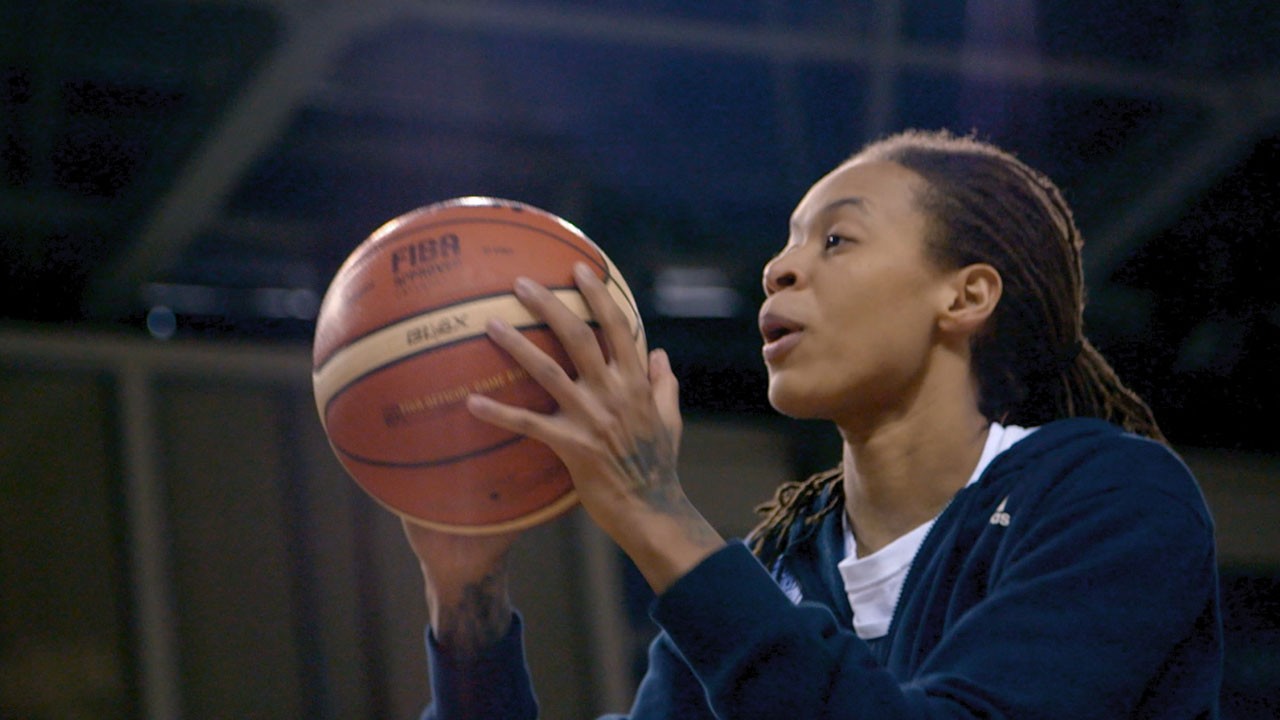Photo by Tony Duffy/All Sport via Getty Images
When it comes to women in basketball, Sheryl Swoopes was as big a star as you could get.The six-foot-champion hailing from Texas became the first woman to be signed to the WNBA during its inception in 1995. Swoopes went on to become a four-time WNBA Championship winner, three-time MVP, three-time Olympic gold medalist, and the first ever women’s basketball player to have their own signature shoe named after them—the iconic Nike Air Swoopes. The only other professional basketball player to have a Nike basketball shoe created in their name and honor at the time was number 23 himself, Michael Jordan, with the Air Jordan first released in 1985. The Air Swoopes' sleek silhouette, bold colorways, and lightweight design made the shoe a must buy for fans when it first debuted in 1995. "There’s an S shape on the bottom of that shoe," Marni Gerber, the senior design director at Nike who designed the Swoopes told WBUR in a recent interview. "Basically, when she's up in the air, that was to put Sheryl Swoopes — SS — in your face. The kind of swirliness of that logo with Sheryl’s name was to show the feminine side of her.”After Swoopes’ shoe in 1995, Nike would go on to work with Lisa Leslie on her Air Total 9s in 1998 and Dawn Staley on her Nike Air Zoom S5 in 1999—but the brand hasn’t made another signature shoe for an WNBA player in 20 years. In 2011, Maya Moore’s endorsement deal with Nike resulted in two “inspired” shoes, but they were both made in extended children’s sizes. In a recent interview with the Los Angeles Times, Swoopes said that looking back on when her signature shoe first debuted is a moment where she “still get[s] a little choked up” — especially considering when she was growing up she couldn’t even afford to buy a pair of Nikes.“Sheryl was just iconic,” Ticara Devone, style editor of the women-centered sneaker site CNK Daily tells Broadly. “She had undeniable talent and showmanship. I think her receiving her own shoe inspired a generation of women athletes, no matter what level they were at, that this is something they could also achieve. She opened the door for many others to be able to have major collaborations with brands, even women who aren't considered athletes but just love sneakers.”
The Air Swoopes' sleek silhouette, bold colorways, and lightweight design made the shoe a must buy for fans when it first debuted in 1995. "There’s an S shape on the bottom of that shoe," Marni Gerber, the senior design director at Nike who designed the Swoopes told WBUR in a recent interview. "Basically, when she's up in the air, that was to put Sheryl Swoopes — SS — in your face. The kind of swirliness of that logo with Sheryl’s name was to show the feminine side of her.”After Swoopes’ shoe in 1995, Nike would go on to work with Lisa Leslie on her Air Total 9s in 1998 and Dawn Staley on her Nike Air Zoom S5 in 1999—but the brand hasn’t made another signature shoe for an WNBA player in 20 years. In 2011, Maya Moore’s endorsement deal with Nike resulted in two “inspired” shoes, but they were both made in extended children’s sizes. In a recent interview with the Los Angeles Times, Swoopes said that looking back on when her signature shoe first debuted is a moment where she “still get[s] a little choked up” — especially considering when she was growing up she couldn’t even afford to buy a pair of Nikes.“Sheryl was just iconic,” Ticara Devone, style editor of the women-centered sneaker site CNK Daily tells Broadly. “She had undeniable talent and showmanship. I think her receiving her own shoe inspired a generation of women athletes, no matter what level they were at, that this is something they could also achieve. She opened the door for many others to be able to have major collaborations with brands, even women who aren't considered athletes but just love sneakers.” The Air Swoopes went on to have multiple iterations as the years went on like the Air Swoopes II, Air Swoopes Zoom, and Air Swoopes Premiere. The sneaker business also went on to become a multi-billion dollar empire but the same success after the release of the Air Swoopes didn’t repeat itself when it came to other women’s basketball shoe lines at Nike and other brands like adidas, FILA, and Reebok. Experts believe visibility is the number one reason for the gender gap resulting in less women's basketball shoe deals.“Although many deserve the attention and respect of the masses, women athletes don’t occupy as much of the spotlight as their male counterparts,” Peter Verry, Footwear News’ athletic and outdoor editor tells Broadly. “Pro ballers such as Elena Delle Donne and Candace Parker are absolutely incredible, but don’t get talked about nearly as much as even marginally talented NBA stars. Because they’re not being covered in the media nearly as much in pro sports discussions, brands likely don’t feel the need to invest as much in them as the men. And there absolutely is a market out there for them."The stark difference between the WNBA and the NBA is based on numbers, attendance, and revenue. Every NBA team is valued at $1 billion or more according to Forbes and gives at least 50 percent of that income to paying their players. In comparison, the WNBA that makes significantly less, pays its female players, under 25 percent of their total revenue. Money talks, and for how little the WNBA chooses to invest in its women athletes, it’s not a surprise that major sports brands will mirror with the same lack of enthusiasm.“[The lack of investment] has something to do with the WNBA overall,” Devone says. “How many people do you know that watch the WNBA games when they come on TV? If we're not watching, then how do we become familiar with whose leading the way in the sport? And if many people aren't watching the game, then how are we going to give someone a signature shoe? I think it starts with that.”
The Air Swoopes went on to have multiple iterations as the years went on like the Air Swoopes II, Air Swoopes Zoom, and Air Swoopes Premiere. The sneaker business also went on to become a multi-billion dollar empire but the same success after the release of the Air Swoopes didn’t repeat itself when it came to other women’s basketball shoe lines at Nike and other brands like adidas, FILA, and Reebok. Experts believe visibility is the number one reason for the gender gap resulting in less women's basketball shoe deals.“Although many deserve the attention and respect of the masses, women athletes don’t occupy as much of the spotlight as their male counterparts,” Peter Verry, Footwear News’ athletic and outdoor editor tells Broadly. “Pro ballers such as Elena Delle Donne and Candace Parker are absolutely incredible, but don’t get talked about nearly as much as even marginally talented NBA stars. Because they’re not being covered in the media nearly as much in pro sports discussions, brands likely don’t feel the need to invest as much in them as the men. And there absolutely is a market out there for them."The stark difference between the WNBA and the NBA is based on numbers, attendance, and revenue. Every NBA team is valued at $1 billion or more according to Forbes and gives at least 50 percent of that income to paying their players. In comparison, the WNBA that makes significantly less, pays its female players, under 25 percent of their total revenue. Money talks, and for how little the WNBA chooses to invest in its women athletes, it’s not a surprise that major sports brands will mirror with the same lack of enthusiasm.“[The lack of investment] has something to do with the WNBA overall,” Devone says. “How many people do you know that watch the WNBA games when they come on TV? If we're not watching, then how do we become familiar with whose leading the way in the sport? And if many people aren't watching the game, then how are we going to give someone a signature shoe? I think it starts with that.”
Advertisement

Advertisement

Advertisement
In recent years, representation in sportswear has shifted from a sole sports-centered aesthetic to a more stylistic slant. One of the greatest athletes of all time, Serena Williams, has her own Nike shoe — but it was designed by Off-White designer Virgil Abloh. In the same realm, high-fashion designers like Stella McCartney and Victoria Beckham have respective lines for Adidas and Reebok that focus on streetwear but do include signature shoes. Even top fashion influencers like Aleaili May are designing their own Jordans. But where are the shoes from the women who have hustled their whole lives to work the court?Verry believes that the work needs to be done within the sports industry to highlight the talent of WNBA players who deserve the same accolades, campaigns, and shoe deals as their male counterparts.“Women athletes deserve to lead more marketing efforts and brands need to utilize their biggest female stars in ways that will promote sport and athletics to young girls who could one day become athletic leaders themselves,” Verry says. “If you show a young person that it’s OK to make sports and athletics a major part of their lives from an early age, there’s a good chance they’ll be an athlete for life.”